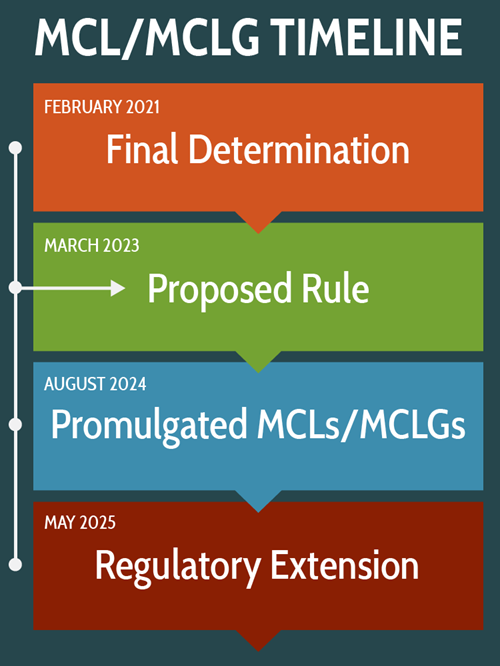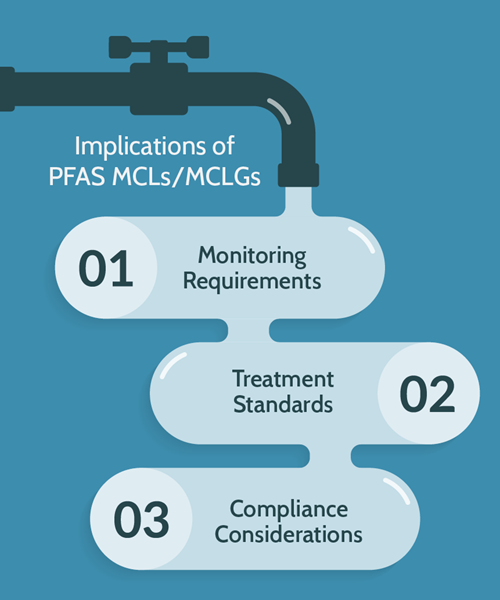4/3/23 Editor's Note: This article was originally published on March 14, 2023, and has been updated to reflect the proposed rule being published to the Federal Register.
____
On March 14, 2023, the Environmental Protection Agency (EPA) released the highly anticipated proposed National Primary Drinking Water Regulation (NPDWR) for perfluorooctanoic acid (PFOA), perfluorooctane sulfonic acid (PFOS), perfluorononanoic acid (PFNA), hexafluoropropylene oxide dimer acid (HFPO-DA; and its ammonium salt), perfluorohexane sulfonic acid (PFHxS), and perfluorobutane sulfonic acid (PFBS). Establishing drinking water regulations related to controlling per- and polyfluoroalkyl substances (PFAS) exposure is the centerpiece of EPA’s Action Plan and Roadmap.
Tell me more about the National Primary Drinking Water Regulation
The NPDWR includes legally enforceable Maximum Contaminant Levels (MCLs), and non-enforceable Maximum Contaminant Level Goals (MCLGs) under the Safe Drinking Water Act (SDWA).
MCLs set the maximum allowable concentration of a contaminant in public drinking water systems, while MCLGs represent the level at which there is no known or expected risk to human health. EPA relies on an independent body of experts called the Science Advisory Board (SAB) to review the scientific basis and implementation feasibility for proposed MCLs and MCLGs through a process involving risk assessment and public comment. MCLGs are generally set to lower levels than the MCL in consideration of the types and costs of treatment technologies available to public drinking water systems.
Once EPA promulgates an MCL and MCLG, public drinking water systems are required to put processes in place to prevent relevant contaminants from occurring in drinking water at levels higher than the MCL. Systems that fail to comply with MCLs are subject to EPA enforcement actions.
How we got here: Retracing EPA’s steps toward the proposed PFAS MCLs and MCLGs
This week’s news is the latest and most significant development in a series of announcements stretching back more than a decade. Before EPA establishes a proposed MCL, it sets a health advisory (HA) for a contaminant. A HA is a non-enforceable guideline that generally serves as a placeholder until a legally enforceable MCL is determined. In 2009, EPA released the original provisional HAs for PFOS/PFOA. EPA then revised the HAs in 2016 and again in 2022. The most notable rulemaking development along the way occurred in February 2021 when EPA made the final determination to regulate PFOA/PFOS under the SDWA, thereby setting the table to propose future MCLs and MCLGs (see Figure 1). Fast forward to today and we arrive at the draft MCLs and MCLGs shown in Table 1.
Figure 1: MCL/MCLG Timeline

Table 1: PFAS Drinking Water Limits Summary
|
PFAS Chemical
|
2009 Health Advisory Level (ppt)
|
2016 Health Advisory Level (ppt)
|
2022 Health Advisory Level (ppt)
|
2023 Proposed MCLG (ppt) |
2023 Proposed MCL (ppt)
|
|
PFOA
|
400
|
70
|
0.004*
|
Zero |
4
|
|
PFOS
|
200
|
70
|
0.02*
|
Zero |
4
|
| PFNA |
NA |
NA |
NA |
HI=1 |
HI=1 |
| HFPO-DA |
NA |
NA |
10 |
| PFHxS |
NA |
NA |
NA |
| PFBS |
NA |
NA |
2,000 |
NA = Not available
* = Interim
ppt = Parts per trillion (or nanograms per liter [ng/L])
HI = Hazard index
Explaining EPA’s Proposed NPDWRs for PFAS
Numerical Limits
Numerical limits MCLs for PFOA and PFOS are intuitive in their intent as individual not to exceed concentration criteria in drinking water. Notable is EPA’s implicit acknowledgement of ensuring that reliable detection limits can be met and suitable remediation technologies are available. Commercial laboratories have technologies to measure 4 ppt (4.0 ng/L) using EPA’s analytical methods and procedures, and existing commercially available water treatment systems (e.g., activated carbon, anion exchange, and high-pressure membrane technologies) are able to treat drinking water to sub-ppt/ng/L levels.
“No Amount of PFAS is Safe”
The proposed MCLGs for PFOA and PFOS of zero ppt/ng/L, put EPA as the “winner” of the recent “race to zero” trend. The stated rationale for “no PFOA/PFOS allowances in MCLG” is that “…EPA has determined that PFOA and PFOS are likely to cause cancer (i.e., liver and kidney), and that there is no dose below which either chemical is considered safe…” Additional scientific debate and public comment is likely.
PFAS Mixture MCLs/MCLGs Hazard Indices
The proposed HI approach for an enforceable MCL for a combination of one or more of PFNA, PFHXs, PFBS, and HFPO-DA is highly unusual and unprecedented in the history of MCL development. Essentially, the proposed HI approach requires the regulatory community to perform a risk assessment where the detected concentrations of the four PFAS are divided by corresponding toxicity reference values and resulting quotients (i.e., Hazard Quotients [HQ]) summed together (assuming dose additivity) to determine if the combined levels of these PFAS pose a potential risk. The EPA rationale for proposing the HI approach is to protect communities from the additive effects of multiple PFAS that may be present in drinking water. The non-cancer effects, which the proposed HI MCLs are intended to protect the public against, are discussed by EPA as related to impairment in thyroid hormone levels, lipid synthesis and metabolism, development, and immune/liver function. The unconventional HI MCL approach will no doubt be subject to vigorous scientific and public debate.
How will PFAS MCLs and MCLGs impact the regulated community?
Whereas MCLGs are not enforceable under the SDWA, MCLs are legally required and shall consider not only public health impacts, but also analytical, treatment, and implementation cost considerations. Further, PFAS MCLs require the following:
- Monitoring: Impacted facilities will have to test drinking water for the six PFAS compounds specified in the rule.
- Public Notification: Water systems will have to notify the public if results exceed the PFAS MCLs.
- Treatment: Public water systems will be required to reduce any PFAS concentrations above the MCLs or provide alternate water supply.
Based on the current analytical laboratory technology, remediation options available, and high costs associated with PFAS, the proposed MCLs in the single ppt/ng/L range, although academically feasible, may be practically challenging for the regulated community to implement, especially for smaller drinking water systems.
Figure 2: Key implications of the proposed MCLs/MCLGs

What analytical method is EPA specifying for MCLs?
The proposed MCLs are to be analyzed via EPA 537.1, which measures 18 PFAS compounds, and/or EPA 533, which measures 25 PFAS compounds. Relatedly, under SDWA, EPA published a final rule requiring public water systems serving 3,300 or more people to collect national occurrence data for 29 PFAS chemicals under the Unregulated Contaminant Monitoring Rule (UCMR) 5. Sampling commenced earlier this year. The results from this sampling effort will become part of the PFAS compliance assessment.
What’s next?
The proposed rule was published to the Federal Register on March 29, 2023, under Docket ID: EPA-HQ-OW-2022-0114. The 60-day public comment period is open through May 30, 2023.
EPA's Virtual Public Hearing
Curious about how the latest PFAS news impacts you? We can help.
If you have PFAS-related questions, concerns, or challenges, drop your information into our contact form and we’ll schedule time to discuss how you can prepare for and manage PFAS-related regulations.
Upcoming free PFAS seminar
